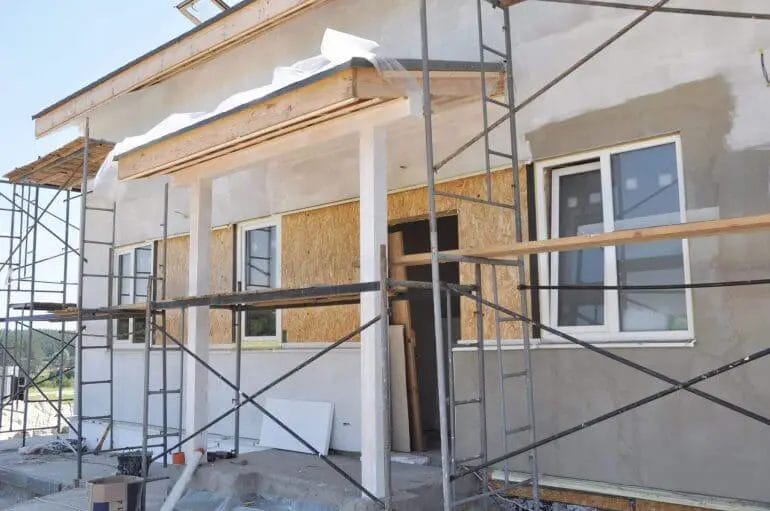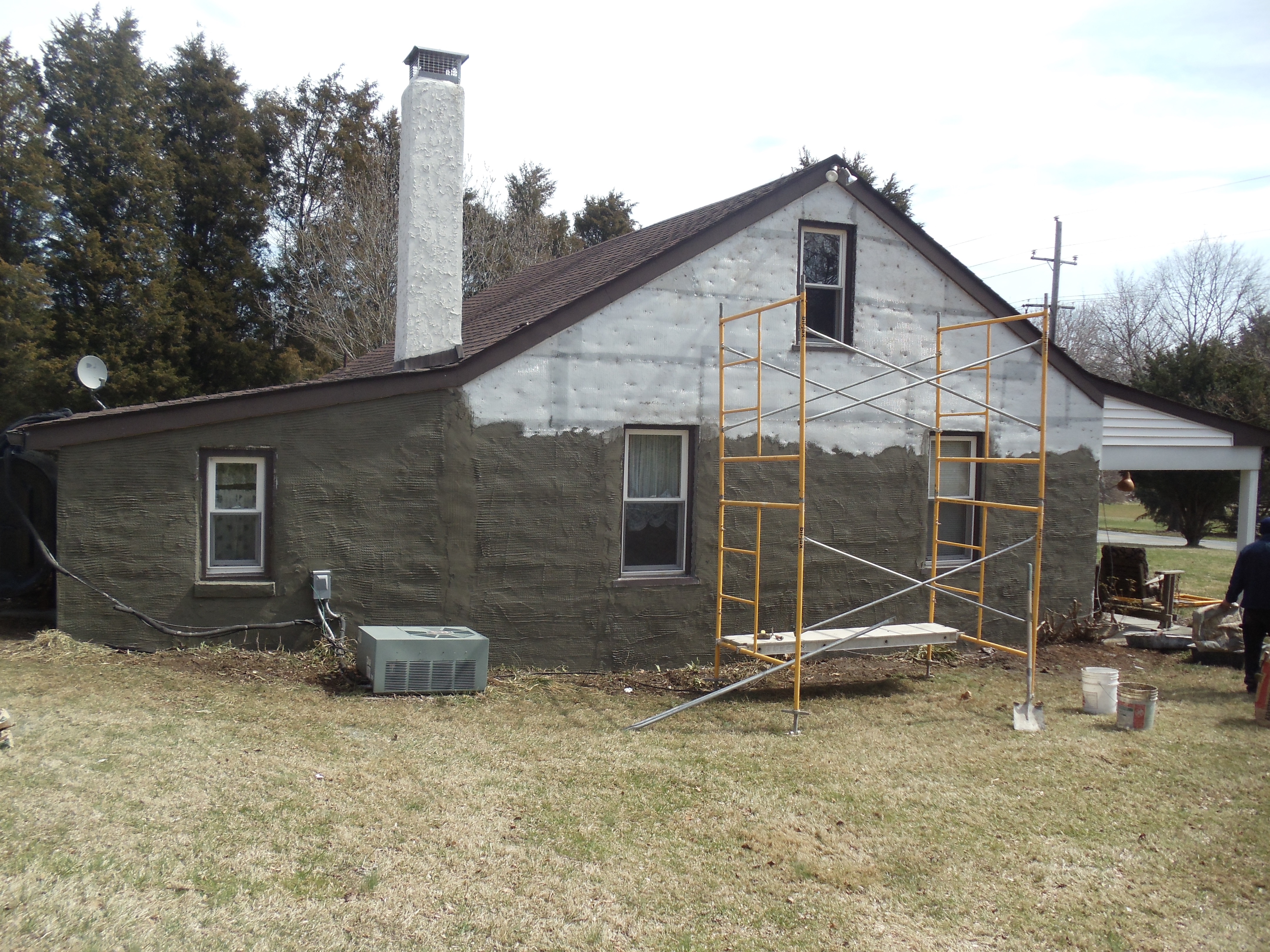Yes, it is possible to stucco over wood surfaces, providing a durable and attractive finish. By following the proper steps and using the right materials, you can transform your wood surfaces into a stuccoed masterpiece. Stucco is a versatile material that can be used to enhance the aesthetics and protection of wood structures. It offers excellent durability, weather resistance, and can withstand the test of time. Whether you are looking to cover an exterior wood siding or a wooden interior wall, stucco can be applied to create a stunning and long-lasting result.

Benefits of Stucco as a Wood Overlay
Stucco is a versatile and durable material that can be used in various applications, including as a wood overlay. By applying stucco over wood surfaces, homeowners can enjoy a range of benefits that enhance the appearance and longevity of their homes. In this section, we will explore the advantages of using stucco as a wood overlay.

1. Enhanced Durability
One of the primary benefits of using stucco as a wood overlay is the enhanced durability it provides. Stucco creates a protective layer over the wood, shielding it from external elements such as moisture, UV rays, and pests. This added protection helps to prevent rotting, warping, and decay, significantly extending the lifespan of the wood surfaces.
2. Improved Insulation
Another advantage of stucco as a wood overlay is the improved insulation it offers. Stucco has excellent thermal properties, helping to regulate the temperature inside the home by reducing heat transfer through the wood surfaces. This can lead to energy savings and a more comfortable indoor environment throughout the year.
3. Aesthetic Appeal
Stucco can dramatically enhance the aesthetic appeal of wood surfaces. With a wide range of textures and finishes available, homeowners can customize the appearance of their wood overlay to match their desired style preferences. Whether it’s a smooth and sleek finish or a more textured and rustic look, stucco can transform the appearance of wood surfaces and add a touch of sophistication to any home.
4. Low Maintenance
Wood surfaces require regular maintenance, including staining, sealing, and repainting, to prevent deterioration. However, by applying stucco as a wood overlay, homeowners can significantly reduce the amount of maintenance required. Stucco is resistant to cracking, fading, and peeling, which means less time and effort spent on upkeep. Additionally, stucco is easy to clean and can be refreshed with a simple wash, keeping the wood overlay looking fresh and vibrant for years to come.
5. Cost-Effective Solution
Using stucco as a wood overlay is a cost-effective solution compared to alternative methods. Instead of completely replacing or repairing damaged wood surfaces, stucco can be applied directly over the existing wood, saving on material and labor costs. This makes it an affordable option for homeowners looking to enhance the durability and visual appeal of their wood surfaces without breaking the bank.
In summary, stucco offers numerous benefits as a wood overlay. From enhanced durability and improved insulation to aesthetic appeal and low maintenance, stucco provides a cost-effective solution for homeowners looking to protect and enhance their wood surfaces. Consider utilizing stucco as a wood overlay to enjoy these advantages and transform the look and longevity of your home.

Step-by-Step Guide to Stuccoing Over Wood
If you want to add a durable and aesthetically pleasing finish to your wood surface, stucco is a great choice. Stucco provides excellent protection against the elements and can enhance the appearance of your wood siding, fence, or any other wooden structure. In this section, we will provide a detailed step-by-step guide on how to stucco over wood.
Materials You Will Need:
- Stucco mix
- Wire mesh
- Scratch coat mix
- Scratch coat trowel
- Finishing coat mix
- Finishing coat trowel
- Metal lath
- Galvanized nails
- Water
- Mixing container
- Stiff brush
- Joint compound
- Paint
Step 1: Prepare the Wood Surface
The first step is to prepare the wood surface for stucco application. Start by cleaning the wood thoroughly to remove any dirt, debris, or loose paint. Use a stiff brush to scrub the wood surface and ensure it is clean and free from any contaminants that may hinder adhesion.
Step 2: Secure Metal Lath
To provide a strong base for the stucco, you will need to attach metal lath to the wood surface. Cut the metal lath into appropriate sizes to fit the area you will be stuccoing. Use galvanized nails to secure the metal lath to the wood. Make sure the lath is tightly attached and does not have any loose spots.
Step 3: Apply the Scratch Coat
Next, mix the scratch coat according to the manufacturer’s instructions. Apply a layer of scratch coat to the prepared wood surface using a scratch coat trowel. The scratch coat should be about 1/4 to 1/2 inch thick. Make sure the scratch coat is evenly applied and covers the entire surface.
Step 4: Create a Scratch Pattern
While the scratch coat is still wet, use the scratch coat trowel to create a scratch pattern. This will provide a rough surface for the finishing coat to adhere to. Use vertical and horizontal strokes to create a textured pattern. Allow the scratch coat to dry for at least 48 hours.
Step 5: Apply the Finishing Coat
Once the scratch coat is dry, mix the finishing coat according to the manufacturer’s instructions. Apply a layer of finishing coat to the scratch coat using a finishing coat trowel. The finishing coat should be about 1/8 to 1/4 inch thick. Smooth out any uneven areas and ensure the entire surface is covered.
Step 6: Finishing Touches
After applying the finishing coat, use a trowel or sponge to create the desired texture on the stucco surface. You can create smooth, rough, or textured finishes depending on your preference. Allow the stucco to cure for at least a week before applying any paint or sealant.
Step 7: Paint or Seal the Stucco
Once the stucco has fully cured, you can paint it to match your desired color scheme or apply a protective sealant. Choose a high-quality exterior paint that is suitable for stucco surfaces. Apply the paint according to the manufacturer’s instructions, ensuring even coverage.
In summary, stuccoing over wood requires careful preparation of the wood surface, securing metal lath, applying a scratch coat, creating a scratch pattern, applying a finishing coat, and adding the desired texture. By following this step-by-step guide, you can achieve a beautiful stucco finish that will enhance the durability and visual appeal of your wood structure.

Tips for Achieving a Seamless Stucco Finish on Wood
Stucco is a popular choice for exterior finishes due to its durability and aesthetic appeal. When it comes to applying stucco on wood surfaces, however, there are a few considerations to keep in mind to ensure a seamless finish. In this section, we will explore some helpful tips for achieving a flawless stucco finish on wood.
1. Prepare the Surface
Before applying stucco, it is crucial to properly prepare the wood surface. Start by cleaning the surface to remove any dirt, dust, or debris. Use a power washer or a stiff brush for effective cleaning. Next, inspect the wood for any signs of damage or rot. If you come across any damaged areas, replace the wood or make necessary repairs before proceeding.
Once the wood surface is clean and free of any damage, apply a high-quality primer. A primer not only helps promote adhesion but also provides a protective barrier between the wood and stucco. Allow the primer to dry completely before moving on to the next step.
2. Apply a Bonding Agent
To ensure a strong bond between the wood and stucco, apply a bonding agent to the primed surface. A bonding agent improves the adhesion of the stucco by creating a chemical bond with the wood. Follow the manufacturer’s instructions for proper application and drying time.
3. Use the Right Type of Stucco
Choosing the right type of stucco is essential for achieving a seamless finish on wood. Opt for a stucco mix that is specifically formulated for wood surfaces. These mixes are designed to provide flexibility, allowing for natural movement in the wood without cracking or crumbling. Additionally, consider using a stucco mix with acrylic additives for increased durability and water resistance.
4. Apply Stucco in Thin Layers
When applying stucco on wood, it is recommended to do so in thin layers rather than thick coats. Thin layers allow for better control and reduce the risk of cracking. Start with a scratch coat, which is a thin layer of stucco applied directly to the wood surface. Use a trowel to scratch the surface, creating a rough texture that helps the next layer adhere properly.
After the scratch coat has dried, apply a brown coat. This second layer should be slightly thicker than the scratch coat. Use a trowel to spread the stucco evenly, ensuring full coverage of the wood surface. Allow the brown coat to cure before applying the final finish coat.
5. Finishing Techniques
To achieve a smooth and seamless finish, use the right techniques during the final coat application. Wet the stucco surface slightly before applying the finish coat to increase workability. Use a trowel or float to spread the stucco evenly, working in circular or figure-eight motions to blend the stucco and create a uniform texture.
After applying the finish coat, wait for it to partially dry before using a sponge or a brush to lightly texture the surface. This step helps achieve a more natural and aesthetically pleasing look. Allow the stucco to cure fully before painting or applying any additional finishes.
6. Regular Maintenance
Once the stucco finish is complete, it is important to perform regular maintenance to ensure its longevity. Keep an eye out for any signs of damage such as cracks or chips and repair them promptly. Additionally, consider applying a waterproofing sealer every few years to protect the stucco from moisture damage.
In summary, achieving a seamless stucco finish on wood requires proper surface preparation, the use of a bonding agent, selecting the right stucco mix, applying thin layers, using the right finishing techniques, and performing regular maintenance. By following these tips, you can enjoy a flawless stucco finish that enhances the beauty and durability of your wood surfaces.
Common Mistakes to Avoid When Applying Stucco on Wood
Stucco is a popular choice for covering exterior surfaces, including wood. It provides a durable and long-lasting finish that can enhance the overall appearance of your home. However, applying stucco on wood requires careful preparation and execution to ensure a successful outcome. In this section, we will discuss some common mistakes that you should avoid when applying stucco on wood.
1. Insufficient Surface Preparation
One of the most common mistakes when applying stucco on wood is not properly preparing the surface. It is important to ensure that the wood surface is clean, dry, and free from any loose paint or debris. Failure to do so can lead to adhesion issues and a compromised stucco finish. Before applying stucco, make sure to thoroughly clean the wood surface and repair any damaged areas.
2. Lack of Proper Moisture Barrier
Wood is susceptible to moisture damage, and without a proper moisture barrier, water can seep into the wood and cause rotting or warping. It is crucial to install a moisture barrier, such as building paper or a waterproof membrane, between the wood surface and the stucco. This barrier will prevent water infiltration and protect the wood from moisture-related problems.
3. Inadequate Application Thickness
Stucco needs to be applied at a sufficient thickness to provide a strong and durable finish. Applying stucco that is too thin can result in a weak and prone-to-cracking surface. It is important to follow the manufacturer’s guidelines and apply the stucco at the recommended thickness. This will ensure that the stucco adheres properly to the wood and forms a robust coating.
4. Improper Mixing and Application
Properly mixing the stucco materials and applying them correctly is crucial for achieving a high-quality finish. Common mistakes in mixing include adding too much water, not mixing for the recommended time, or not using the right proportions of ingredients. It is essential to follow the instructions provided by the manufacturer to achieve the desired consistency and workability of the stucco mixture.
Additionally, applying stucco in extreme temperatures or under direct sunlight can negatively affect the curing process. It is recommended to apply stucco when the weather conditions are mild and avoid applying it during hot or freezing temperatures.
5. Lack of Proper Curing and Maintenance
After applying stucco on wood, it is crucial to allow it to cure properly. Curing time can vary depending on the climate and stucco type, but generally, it takes several days to weeks. During the curing process, it is important to keep the stucco surface moist by misting it with water. This helps prevent rapid drying and cracking.
Once the stucco has cured, regular maintenance is essential to ensure its longevity. Inspect the stucco surface periodically for any signs of damage or cracking. Repair any small cracks promptly to prevent water infiltration and further damage.
In summary, applying stucco on wood requires proper surface preparation, the use of a moisture barrier, adequate application thickness, correct mixing and application techniques, and proper curing and maintenance. By avoiding these common mistakes, you can achieve a successful and long-lasting stucco finish on wood surfaces.
FAQs
Can you stucco over wood?
Stucco can be applied over wood surfaces, but proper preparation is essential. The wood needs to be clean, dry, and free from rot or damage. Applying a metal lath and a scratch coat of stucco will provide a suitable surface for the final coat. It’s recommended to consult with a professional stucco contractor for best results.
Conclusion:
In conclusion, stucco can be successfully applied over wood surfaces, providing an attractive and durable finish. Whether you are looking to enhance the exterior of your home or add a unique texture to interior walls, stucco offers a versatile solution. By following the proper preparation and application techniques, you can create a long-lasting stucco finish on wood. It is important to ensure that the wood surface is clean, dry, and free from any loose or damaged material before applying the stucco. Additionally, using a bonding agent and applying multiple layers of stucco will help to ensure a strong and solid bond.
Overall, stucco provides a cost-effective and visually appealing option for covering wood surfaces. Its ability to resist weather damage and provide insulation makes it a popular choice among homeowners. So, if you are considering stucco for your wood surfaces, make sure to consult with a professional and follow the necessary steps to achieve a beautiful and long-lasting result.